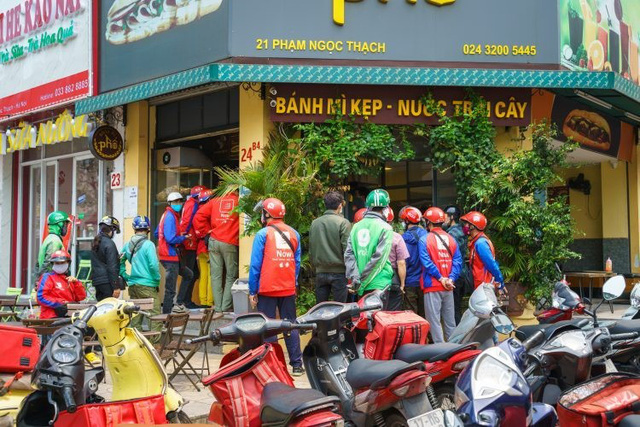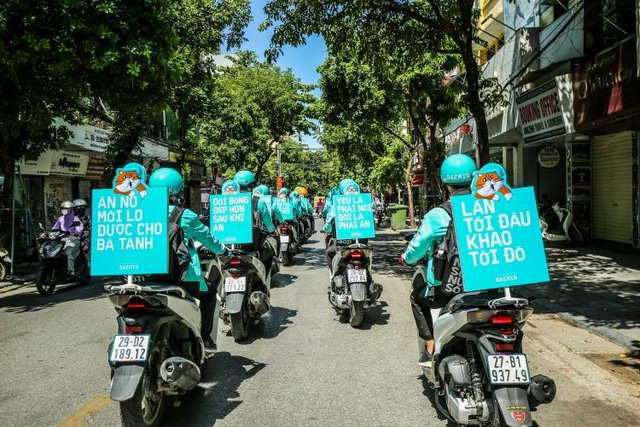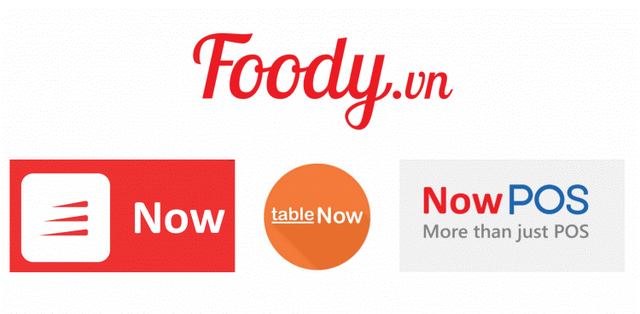Now – The secret weapon of the parent company Shopee in Vietnam: Strongly spent $ 64 million to acquire a startup that delivers food, will it make a story?
- Tram Ho
On August 12, hundreds of drivers working for the food delivery company Now gathered at Foody’s headquarters – the parent company of this application in Hanoi.
Local media said that these drivers were not satisfied with Now’s new bonus policy. However, Foody confirmed that the changes also increased the maximum bonus rate and aimed at improving customer experience.

In recent years, such protests with Grab and Gojek drivers have taken place in many places. These platforms attract users and drivers with discounts and bonuses so conflicts are natural when promotions shrink.
Now has become a famous food ordering application in Vietnam, competing directly with Grab. The lesser known difference is that Now is part of Singapore’s Sea Group. The giant bought Foody for $ 64 million in 2017 – a dream figure for any startup in the region.

Lured by the local startup market, Foody has become a major takeover for Sea. However, e-commerce and games are still Sea’s main businesses. So the question arises as to what role is the food delivery segment playing in their Southeast Asia plan. The answer lies in their next bet: Pay.
Foody has been in business for almost a decade. Founded in 2012 by Minh Dang – a startup as a restaurant and food proposition website.
Itinerary of Now
In 2015, Foody diversified into a transactional platform with food delivery and restaurant reservations after completing a round of funding from Garena and Tiger Global Management. That same year, they launched an on-demand service app called DeliveryNow – now renamed Now.
At that time, being a food delivery platform in Vietnam was considered a pretty bold step. Online food ordering is considered a luxury service for the majority of the expat community living in Hanoi and HCMC.
However, Foody has chosen the right direction and proof that their website works well, connecting users with restaurant owners. When the startup completed its Series C funding round from Tiger Global Management, it reported there were 115,000 restaurants on the platform.
However, the founder has no plans to stop food delivery: He turned to building an ecosystem for Foody to increase user engagement. This has been happening even before Grab and Gojek entered Southeast Asia with the ambition of becoming a super app.
His vision caught on with Sea, which invests in Foody’s Serries B round of funding. DealStreetAsia newspaper then predicted that Sea’s entry into the food sector was aimed at providing more user bases for its AirPay payments segment. More than that, however, Now could have the potential to expand Sea’s offerings and user base in Southeast Asia.
Of course, everyone knows, Grab and Gojek have quickly dominated the food ordering segment in Southeast Asia. And of course in Vietnam, Now, competition is very fierce.
Food delivery market in Vietnam is “not easy”
The size of Vietnam’s food delivery market is relatively small. Revenue from the online food delivery segment here is expected to reach $ 302 million in 2020 according to Statista’s statistics. This is 275 million USD higher than Thailand, but far behind Indonesia is 1.9 billion USD and Singapore is 464 million USD.
Food delivery is currently a low-margin segment. Even big players like UberEats and DeliveryHero are not profitable. The main factor is how to still increase order volume and reduce costs.
Currently, demand for online food delivery in Vietnam comes mainly from Hanoi and Ho Chi Minh City – with a total population of 17 million people. One forecast is for a boom in food delivery in Southeast Asia. Over the past four years, inquiries about online food delivery brands has increased by more than 13 times in Indonesia, nine times in the Philippines and eight times in Thailand, but only twice in Vietnam.
In 2012, the demand in Vietnam was very low, causing some units to withdraw. In 2015, Rocket Internet withdrew from the country after only 3 years – 1 year before they also withdrew from Indonesia. Rocket Internet sells Foodpanda to rival Vietnammm for about $ 500,000.
A former Foodpanda leader in Singapore once shared that: “Rocket cannot have the patience to make its operations in Vietnam become more stable and effective”.
After that, Grab’s entry has made significant changes.
Launched in 2018, GrabFood has rapidly operated in 18 cities in Vietnam and leveraged its network of 190 car and motorbike drivers. They also own a cashless payment system after partnering with Moca.
Nguyen Thai Hai Van – Managing Director of Grab Vietnam since January said in a statement that the number of restaurants joining their platform in Q2 2020 has tripled from the previous quarter. Grab has seen “a natural shift of existing ride-hailing customers to food delivery”.

Grab has an optimistic view of Vietnam. Last year, the company announced an investment of $ 500 million here, considering Vietnam the second most important market after Indonesia. However that ambition only had potential until before the arrival of Covid-19 translation.
Unlike Indonesia, however, Grab did not have to compete in the first place with Gojek. As a result, they moved faster to maximize that advantage: GrabFood is available in more regions than Now – only in 16 provinces.
In response to Covid-19, Grab also quickly introduced GrabMart and GrabAssistant – services Now provided before the pandemic.
However, Foody is still optimistic about the advantage of its predecessor. A Foody spokesman said that the food delivery market in Vietnam has grown exponentially. Taking advantage of Sea’s ecosystem, the company added AirPay to NowFood. Shopee users can also place orders through NowFood.
However, Now, Now does not only have to compete with Grab because Gojek has just taken a new step into Vietnam. Following a new round of raising capital of 1.2 billion USD, Gojek has changed its brand identity in Vietnam and Thailand according to its parent company in Indonesia.
Gojek’s statement in Vietnam places a heavy burden on the food delivery app market. The announcement shows that they offer a few new features such as the option for users to pin delicious food with GoFood, sharing photos between customers and drivers, and support for placing multiple orders on our services. Ecology Gojek.
Gojek claims it already has 150,000 drivers and 80,000 restaurants in Hanoi and Ho Chi Minh City operating on the platform. However, Gojek users still have to pay cash.
When asked about its intentions for these services, Gojek’s newly appointed CEO Phung Tuan Duc said in a handwritten statement that the company is focusing on “instant change is smooth” with the platform. new.
Another formidable opponent is Baemin – who entered Vietnam since May 2019. Baemin is part of Woowa Brothers – a Korean tech unicorn acquired by DeliveryHero for $ 4 billion.

Baemin started out in Ho Chi Minh City and only expanded to Hanoi in June this year. An industry insider said the company chose to “go slowly but surely” to challenge other competitors including Grab and Now.
That means they focus on serving Hanoi and HCMC. Typically, Baemin’s users can only order from the seller within a 5km radius from the location.
An industry source added: “Why did Foodpanda fail? At that time, Vietnam was ready for the food delivery business. Currently, the Vietnamese market is good enough if the platform can handle it. markets in Hanoi and Ho Chi Minh City with a population of nearly 20 million people and income is increasing significantly “.
Like elsewhere affected by Covid-19, restaurant and restaurant owners in Vietnam are very open to these platforms despite commissions as high as 25-35%.
Quynh Anh, a member of the group of 2,000 members of the food industry, says complaints about these apps are often about high commission fees and lack of access to customer data. However, “using food delivery apps is a must for restaurant owners, especially for brands that are in need of new customers”.
So why does Sea want to jump into the food delivery business?
A former Now manager told Techinasia that the platform’s “remarkable growth” mostly happened before they were bought by Sea. The food delivery market is now more competitive. “Obviously not easy to go from 200,000 orders a day to 300,000.” With Sea’s support, there will be an immediate improvement in technology with Now. Back in the day, Now would be chaotic if it handled too many orders.
However, the market has not yet won because Baemin has just entered the market. In recent months, Now and Baemin have gained more active users even though Baemin’s number is half that of Now. GrabFood currently does not have official statistics.
It is not yet clear that the competitor is the dominant player despite entering the market early. A recent survey by research firm Q&I found that 79% of respondents said GrabFood was the most popular food delivery app, 56% chose Now.

Foody’s 2018 filings show that Sea owns 99% of the business instead of 84% in 2017, which means they have poured more money here. Unlike Grab and Gojek, Sea is in an enviable position of owning $ 3.43 billion in cash and possibly reducing losses.
However, does Sea want to invest more in Foody?
An analyst said that Sea is capable of handling a business like Foody because they are relatively small compared to Sea’s current capitalization – nearly $ 70 billion.
Currently, the conglomerate is acting effectively with Shopee in terms of market share and has “the ability to continue offering discounts thanks to money generated from the game segment”.
The problem, however, is whether Foody can be a good money machine, especially if it expands overseas and faces tough competitors. Sea already has two businesses that are burning a lot of money: Shopee and SeaMoney. Adding one more array would be too much.
In the past, Foody entered the Indonesian market but things were not successful.
Just focusing on Vietnam might not be a bad idea. After all, food delivery is a highly local business and Foody can manage costs by concentrating resources in one country. Besides, they also do not really need to deliver items in many markets to serve the goal of finding users for SeaMoney.
In the IPO prospectus, Sea said the goal of acquiring Now Vietnam is to “further expand the offering services and user base in Southeast Asia and strengthen the ecosystem of AirPay users”.
While the battle with food delivery apps between grab and Sea will be more and more difficult for Vietnam, another battle to dominate financial technology is also underway.
Source : Genk
